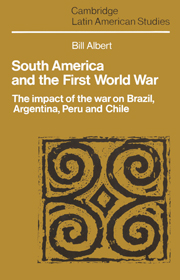Book contents
- Frontmatter
- Contents
- Tables
- Acknowledgments
- Introduction
- 1 Before the War
- 2 The early impact of the War
- 3 The recovery of trade during the War
- 4 Seeking financial solutions
- 5 The War and the growth of manufacturing industry
- 6 The War and the workers
- 7 After the War
- Notes
- Bibliography
- Index
- CAMBRIDGE LATIN AMERICAN STUDIES
4 - Seeking financial solutions
Published online by Cambridge University Press: 22 October 2009
- Frontmatter
- Contents
- Tables
- Acknowledgments
- Introduction
- 1 Before the War
- 2 The early impact of the War
- 3 The recovery of trade during the War
- 4 Seeking financial solutions
- 5 The War and the growth of manufacturing industry
- 6 The War and the workers
- 7 After the War
- Notes
- Bibliography
- Index
- CAMBRIDGE LATIN AMERICAN STUDIES
Summary
Introduction
The dislocation of Latin American finances brought about by the outbreak of war was savage but, given that the region's economies had been so closely tied to the international system, this was to be expected. Similar events were repeated throughout the world not only in dependent primary exporters, but also in such a powerful industrial country as the United States. The question pursued in this chapter is not so much whether or not crises were initiated in the centre and then spread to the periphery, but rather how by looking at events during the war we can begin to understand more clearly how the course of peripheral capitalist change was influenced by the nature of the various domestic financial systems, and how these systems themselves were, in many important respects, shaped by external forces. These are issues which, surprisingly, have received little critical attention. Scholars have identified particular problems, such as reliance on capital imports, or the key role played by foreign banks, but capitalism creates and comes to rely upon an integrated financial structure for its development and these structures in Latin America have not been systematically investigated. By “financial structure” is meant not only institutions such as banks, insurance companies, the stock exchange, etc., but also the framework which conditioned the formation of governments' fiscal and monetary policies as well as the larger international financial network, including in this the massive inflow of foreign capital.
- Type
- Chapter
- Information
- South America and the First World WarThe Impact of the War on Brazil, Argentina, Peru and Chile, pp. 122 - 179Publisher: Cambridge University PressPrint publication year: 1988

